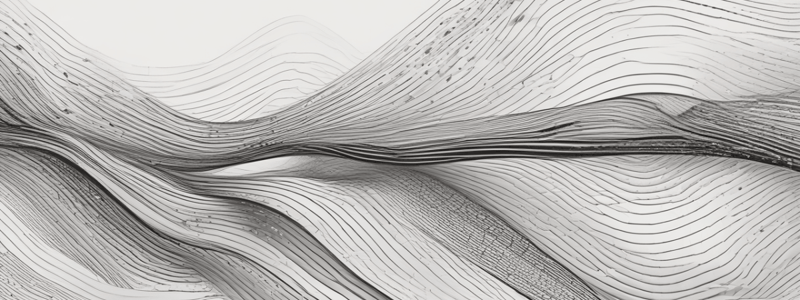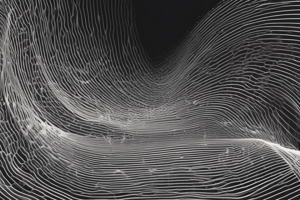Podcast
Questions and Answers
What happens to intensity when there is a decrease in area?
What happens to intensity when there is a decrease in area?
- It becomes zero
- It remains the same
- It decreases
- It increases (correct)
What is the term for the weakening of an ultrasound pulse as it travels through a medium?
What is the term for the weakening of an ultrasound pulse as it travels through a medium?
- Diffraction
- Refraction
- Frequency shift
- Attenuation (correct)
What is amplitude in the context of sound waves?
What is amplitude in the context of sound waves?
- The total amount of variation that occurs in an acoustic variable
- The average amount of variation that occurs in an acoustic variable
- The minimum amount of variation that occurs in an acoustic variable
- The maximum amount of variation that occurs in an acoustic variable (correct)
What is the purpose of the 'dead time' in pulsed ultrasound?
What is the purpose of the 'dead time' in pulsed ultrasound?
What is the term for the 'on' or 'transmit' time in pulsed ultrasound?
What is the term for the 'on' or 'transmit' time in pulsed ultrasound?
What is the frequency bandwidth in pulsed ultrasound?
What is the frequency bandwidth in pulsed ultrasound?
What type of ultrasound is predominantly used in echocardiography?
What type of ultrasound is predominantly used in echocardiography?
What is the period of a sound wave if one cycle takes 0.2 μs to occur?
What is the period of a sound wave if one cycle takes 0.2 μs to occur?
What type of images can pulsed wave transducers generate?
What type of images can pulsed wave transducers generate?
What is the unit of measurement for wavelength?
What is the unit of measurement for wavelength?
What is the frequency of a sound wave if one cycle takes 0.2 μs to occur?
What is the frequency of a sound wave if one cycle takes 0.2 μs to occur?
What determines the period of a sound wave?
What determines the period of a sound wave?
What is the wavelength of a sound wave if the speed of sound is 1.54 mm/μs and the frequency is 5 MHz?
What is the wavelength of a sound wave if the speed of sound is 1.54 mm/μs and the frequency is 5 MHz?
What is the effect of shorter-wavelength sound waves on ultrasound images?
What is the effect of shorter-wavelength sound waves on ultrasound images?
What is the propagation speed of a sound wave dependent on?
What is the propagation speed of a sound wave dependent on?
Can the wavelength of a sound wave be controlled by the sonographer?
Can the wavelength of a sound wave be controlled by the sonographer?
What is the material in which the average propagation speed of sound is the fastest?
What is the material in which the average propagation speed of sound is the fastest?
What is the amplitude of a sound wave indicative of?
What is the amplitude of a sound wave indicative of?
What is the unit of power in diagnostic ultrasound?
What is the unit of power in diagnostic ultrasound?
What happens to the intensity of a sound wave when the area is increased?
What happens to the intensity of a sound wave when the area is increased?
What is the unit of intensity in ultrasound?
What is the unit of intensity in ultrasound?
What is the purpose of the power of a sound wave in ultrasound?
What is the purpose of the power of a sound wave in ultrasound?
What is the relationship between the power of a sound wave and its ability to displace particles?
What is the relationship between the power of a sound wave and its ability to displace particles?
What is the rate at which energy passes through a unit area in ultrasound?
What is the rate at which energy passes through a unit area in ultrasound?
What is the unit of Pulse Repetition Period (PRP)?
What is the unit of Pulse Repetition Period (PRP)?
What is the effect of increasing the imaging depth on Pulse Repetition Frequency (PRF)?
What is the effect of increasing the imaging depth on Pulse Repetition Frequency (PRF)?
What is the relationship between Pulse Repetition Period (PRP) and Pulse Repetition Frequency (PRF)?
What is the relationship between Pulse Repetition Period (PRP) and Pulse Repetition Frequency (PRF)?
What is the typical range of Pulse Repetition Period (PRP) values in clinical imaging?
What is the typical range of Pulse Repetition Period (PRP) values in clinical imaging?
What is the formula to calculate Pulse Duration (PD)?
What is the formula to calculate Pulse Duration (PD)?
What is the effect of decreasing the number of cycles in a pulse on Pulse Duration (PD)?
What is the effect of decreasing the number of cycles in a pulse on Pulse Duration (PD)?
What is the duty factor (DF) of an ultrasound system?
What is the duty factor (DF) of an ultrasound system?
What is the formula to calculate the period of a pulse?
What is the formula to calculate the period of a pulse?
What is the purpose of the listening time in pulsed ultrasound systems?
What is the purpose of the listening time in pulsed ultrasound systems?
What is the typical range of duty factors for sonography?
What is the typical range of duty factors for sonography?
What is the formula to calculate the duty factor (DF)?
What is the formula to calculate the duty factor (DF)?
What is the duty factor for an ultrasound examination with a pulse duration of 2 µs and a pulse repetition period of 1 ms?
What is the duty factor for an ultrasound examination with a pulse duration of 2 µs and a pulse repetition period of 1 ms?
What is the spatial pulse length (SPL) dependent on?
What is the spatial pulse length (SPL) dependent on?
What determines axial resolution in ultrasound imaging?
What determines axial resolution in ultrasound imaging?
What happens to the spatial pulse length (SPL) as frequency increases?
What happens to the spatial pulse length (SPL) as frequency increases?
What is the spatial pulse length (SPL) equal to?
What is the spatial pulse length (SPL) equal to?
Flashcards are hidden until you start studying
Study Notes
Sound Wave Parameters: Period
- The period (T) is determined by the sound source and cannot be altered by the sonographer.
- Each cycle occurs in a specific time, and the period is the time for one cycle to occur.
- If one cycle takes 0.2 μs to occur, the frequency is 5 MHz.
Sound Wave Parameters: Wavelength
- Wavelength (λ) is the length of a cycle in space.
- Units for wavelength are measured in meters, millimeters, or any standard unit of length.
- Typical values in soft tissue range from 0.1 to 0.8 mm.
- The wavelength cannot be modified by the sonographer.
- Wavelength is calculated as Speed divided by Frequency (λ = c / f).
Sound Wave Parameters: Propagation Speed
- Propagation speed (c) refers to the rate at which a sound wave moves through a medium.
- Within a specific medium, sound waves travel at a consistent speed, regardless of their frequency.
- The speed of sound wave propagation varies across different mediums.
- The average propagation speed of sound in tissues:
- Air: 330 m/sec
- Fat: 1450 m/sec
- Water: 1480 m/sec
- Soft tissue: 1540 m/sec
- Bone: 4100 m/sec
Sound Wave Parameters: Amplitude
- Amplitude is created by the number of molecules displaced by a vibration.
- Amplitude is indicative of the strength or intensity of a sound wave.
- Amplitude is typically measured in units of pressure, such as Mega Pascals (MPa).
Sound Wave Parameters: Power
- Power is the rate at which work is performed or energy is transferred.
- In ultrasound, power refers to the generation of ultrasound waves by the transducer and their propagation through tissues.
- The standard unit of power is the Watt (W).
- Power in diagnostic ultrasound is commonly expressed in milliwatts (mW).
Sound Wave Parameters: Intensity
- Intensity (I) is the rate at which energy passes through a unit area.
- Intensity is equal to the power in a wave divided by the area (A) over which the power is spread.
- Intensity units include milliwatts per centimeter squared (mW/cm²) and watts per centimeter squared (W/cm²).
Pulsed Wave
- A pulse has a distinct beginning and end.
- Pulsed ultrasound comprises two main components: The Cycle (the "on" or "transmit" time) and The Dead Time (the "off" or "receive" time).
- Pulsed transducers are designed to generate multiple, sequential, short pulses, allowing for the simultaneous use of the same crystal or group of crystals for both sound transmission and echo reception.
Pulsed Repetition Frequency (PRF)
- Pulse Repetition Frequency (PRF) refers to the number of sound pulses generated by the transducer per second.
- The determination of PRF is attributed to the sound source and can be adjusted by the sonographer.
- There is an inverse relationship between imaging depth and PRF, meaning as imaging depth increases, PRF decreases.
Pulse Repetition Period (PRP)
- Pulse-repetition period (PRP) refers to the time from the beginning of one pulse to the beginning of the next one.
- PRP is the reciprocal of Pulse Repetition Frequency (PRF), expressed in milliseconds or any unit of time (PRP = 1 / PRF).
- The determination of PRP is influenced by the sound source, and it can be adjusted by the operator.
Pulse Duration (PD)
- Pulse duration (PD) is the time that it takes for one pulse to occur.
- PD is equal to the period (the time for one cycle) times the number of cycles in the pulse (n) and is expressed in microseconds (PD = n × T).
- Sonographic pulses are typically two or three cycles long, while Doppler pulses are typically 5 to 30 cycles long.
Duty Factor (DF)
- The duty factor is the percentage of time that the ultrasound system transmits sound.
- DF is the fraction of the PRP that the sound is on.
- Typical DFs for sonography are in the range of 0.1% to 1.0%, and for Doppler ultrasound, the range is 0.5% to 5.0%.
- The sonographer can adjust the duty factor when changing imaging depth.
Spatial Pulse Length (SPL)
- SPL is the length of a pulse from front to back.
- SPL is equal to the length of each cycle times the number of cycles in the pulse (SPL = n × wavelength).
- SPL determines axial resolution.
- Because wavelength decreases with increasing frequency, SPL decreases with increasing frequency.
Studying That Suits You
Use AI to generate personalized quizzes and flashcards to suit your learning preferences.





